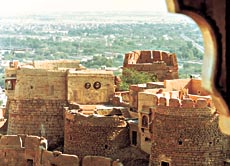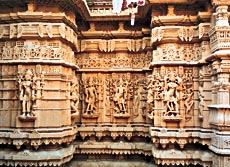




















 

 |
The pull
of the golden fort
By Shona
Adhikari
I WAS finally able to go to
Jaisalmer a little over a year ago. It had been down as a
priority on my list of ‘must see’ places, but
somehow, though I had visited Jodhpur at least 15 times,
I was just not able to find time for the five-hour car
journey, that is required to visit Jaisalmer from
Jodhpur. However, the day finally came, and it is
difficult to describe the sense of excitement that
gripped me as we neared the fort.
 I remember my very first view of
Jaisal’s fort — it literally took my breath
away — even though I knew what it would look like.
The fact is there is this straight road that leads to
Jaisalmer, without any trees or roadside habitation to
break the monotony. Then suddenly when one is about 12 km
away, the fort comes into view — perched on a table
mountain, rising up in the desert sands, like a mirage
...like Ray’s Sonar Kella. I remember my very first view of
Jaisal’s fort — it literally took my breath
away — even though I knew what it would look like.
The fact is there is this straight road that leads to
Jaisalmer, without any trees or roadside habitation to
break the monotony. Then suddenly when one is about 12 km
away, the fort comes into view — perched on a table
mountain, rising up in the desert sands, like a mirage
...like Ray’s Sonar Kella.
Like a vision out of a
fairy story, the fort perched on top of a hill, built out
of the rare golden sandstone that is peculiar to the
region, gleams like real gold in the sun. And as I was to
discover later, inside the fort the intricate carved
friezes and jalis seem to glint and turn into
golden lace. It does not surprise me in the least, that
year after year, countless tourists from all over the
world, go home mesmerised after their visits.
Jaisal, the founder of
Jaisalmer, was the ruler of the desert citadel of
Lodruva, which lay 16 km westward. Conscious that his
fortress on the plain was susceptible to invasion, Jaisal
wandered in the neighbourhood to find a more secure
vantage point. Local legend relates that a Brahmin hermit
living by a spring, overlooked by the triple-peaked hill
known as Trikuta, had foretold that a town would be built
by the spring, and a citadel on top of the hill.
True to prophecy, Jaisal
built Jaisalmer in1156, and the inhabitants of Lodruva,
now unprotected, also moved to Jaisal’s new
town-beginning the turbulent history of Jaisalmer, or
‘the hill of Jaisal’. It took seven years to
build the fort, the bastions of which, rise 30 feet above
the rock. The rock itself rises 250 feet above the plain.
A second stage of construction took place around 1577,
when three fine gateways were added. At this time, a
second wall was erected parallel to the first, but only
15 ft high. Both Hindu and Jain temples were built
within. Later in 1633, a further 92 bastions were added,
each with a sentry’s window and a platform from
which cannon could be fired at approaching enemies. The
stone cannon balls can still be seen lying on the walls
of the bastion.
 At the end of the 13th century,
Ala-ud-Din Khilji of Delhi, seized Jaisalmer from Jait
Singh, but was persuaded that Jaisalmer lay too far away
from Delhi to benefit from the ruler’s control.
Thereafter a local ‘Rawal’ (the traditional
name for a rajah in the region), was appointed as deputy
to rule Jaisalmer, with succeeding rulers in Delhi,
continuing the tradition set by Khilji. At the end of the 13th century,
Ala-ud-Din Khilji of Delhi, seized Jaisalmer from Jait
Singh, but was persuaded that Jaisalmer lay too far away
from Delhi to benefit from the ruler’s control.
Thereafter a local ‘Rawal’ (the traditional
name for a rajah in the region), was appointed as deputy
to rule Jaisalmer, with succeeding rulers in Delhi,
continuing the tradition set by Khilji.
However, perhaps the
most momentous incident was perpetuated by the 15th
century ruler Rawal Chachakdeo, who captured the heads of
hundreds of Jain families, and agreed to their release
only after their families had been brought to settle in
Jaisalmer. This certainly assured the long-term
prosperity of the city, but in time the Mehtas who became
the hereditary prime ministers, rose to prominence over
the ruling family itself — to a point where the
sovereigns’ indebtedness led to virtual servility.
With the growth of
Bombay port, the hazardous overland spice route linking
Jaisalmer, lost its importance. Thus it was that in the
19th century Jaisalmer had dwindled in fortune, and in
the days of the Raj, Jaisalmer was the least known of the
Rajputana principalities. But the very fact that the
royal family lacked the funds to modernise, has been the
main reason for the attraction of the place, left as it
were, frozen in time — in another century. Gradually
the population of the city diminished, as people left to
find greener pastures. The city population of 1,15,000,
dwindled to 22,000 in 1989. Now the population is
seasonal, the fort fills up with the arrival of tourists
in the winter months.
One enters through the
‘Ganesh Pol’ or the Elephant Gate, from the
main market, then up a steep incline paved with large
flagstones past ‘Sural Pol’, the Sun Gate. The
old palace is opened only by prior appointment. The
winding path is wide enough to have permitted four fully
armed warriors to ride abreast. Gigantic walls of dry
masonry soar above, emphasising the brooding air of
impregnable power.
 ‘Bhointa Pol’, the Turn Gate,
stands at a sharp curve in the path, and has been the
scene of many a bloody fight. Nearby is a temple of the
warlike ‘Goddess Bhawani’, protectress of the
warrior Bhattis, who prayed to her before going into
battle, with their chilling battle-cry, "Jai
Bhawani". ‘Bhointa Pol’, the Turn Gate,
stands at a sharp curve in the path, and has been the
scene of many a bloody fight. Nearby is a temple of the
warlike ‘Goddess Bhawani’, protectress of the
warrior Bhattis, who prayed to her before going into
battle, with their chilling battle-cry, "Jai
Bhawani".
The ‘Hawa
Pol’, the Wind Gate, stands as a sentinel to the
royal palaces and leads to the main enclosure, the
‘Court of Public Audience’. This is a spacious
square, where the Rawal would hear petitions, review
troops or entertain guests during weddings and festivals.
As one faces the palace, on the left is a white marble
throne for the monarch, reached by a flight of carved
steps.
Among the most
spectacular buildings in the fort is ‘Salim
Singh’s Haveli’, the residence of the Prime
Minister of Jaisalmer, in the 18th century. The haveli
is distinguished by special features. The upper
storey, has an intricately carved balcony running round
the entire building, created in cantilever style. It is
supported by carved brackets and arches. A third storey
is known as ‘Moti Mahal’ and consists of 12
delicate arches, following the same design of the lower
balconies.
An extensive group of
Jain temples dating back to 12th century stand within the
fort complex, said to have been built by donations from
wealthy families. The temples of Rishabdevji, Sambhavnath
and the Ashtapadi Mandir, are the finest in the complex.
Entrance to the Rishabdevji Temple is through intricately
carved ‘Torans’, or scrolled archways. The
‘Panchdhatu’ or five metal images of the Jain
Tirthankars may be seen within the cloistered interior
chambers, where only worshippers are allowed to enter.
However, there are no restrictions on seeing all the
magnificent carvings spread all over the complex,
exquisitely carved images of celestial nymphs. Hindu gods
and goddesses from the Hindu pantheon cover the exterior
walls, ornate pillars, carved spires and ceilings. There
is so much embellishment that one has to take it slowly,
to be able to imbibe the magnificence of the carvings.
On the road that leads
to Jaisalmer, stand the royal cenotaphs of the Rawals, at
‘Burra Bagh’, where the rulers were cremated.
Each ‘chattri’ sports a tablet depicting
the ruler and recording his ‘Sati’ consorts and
concubines. Based on a rocky eminence, this place
deserves a visit, not only because of the chattris,
but also because it is the best location for
photographing the fort.
|

